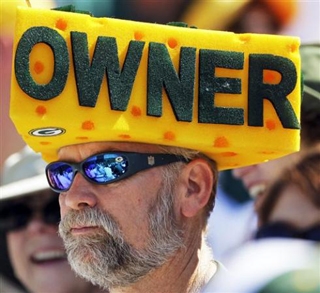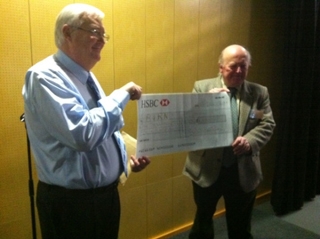
Score! for Two Rural Broadband Teams
[Source: Daily Yonder, by Craig Settles, January 26, 2012]
Can the strategy that raised enough money for a new Packers' stadium finance a rural broadband network? Communities in Vermont and rural Lancashire, England, have kicked off efforts.
 In Green Bay, WI, football fans bought shares in the team to build a new stadium. Local ardor and hustle can raise money for a broadband network, too. Though bumped out of Super Bowl contention, the Green Bay Packers leave broadband advocates with a win: a potent strategy for community ownership of this critical asset.
In Green Bay, WI, football fans bought shares in the team to build a new stadium. Local ardor and hustle can raise money for a broadband network, too. Though bumped out of Super Bowl contention, the Green Bay Packers leave broadband advocates with a win: a potent strategy for community ownership of this critical asset.
In five weeks the community-owned Packers raised $70 million for refurbishing its football field by selling stock in the team. More incredible than raising so much money so quickly is that the $250 stock share price buys the investor very little. The stocks are untradeable, pay no dividends and do not have securities-law protection. Investors don’t even get a game ticket. (There’s a really fun annual shareholders party at the team’s Lambeau Field, though.)
Examining the path Green Bay took to execute this fundraising feat uncovers the seeds for successfully financing a community broadband network. The three main ingredients are belief in the cause, sound planning and a solid needs assessment.
Clearly, belief in their biggest community asset – the Packers team – is phenomenally strong. A share of Packer stock probably isn’t worth much more than a case or two of beer if an investor sells it back to the team. However, to mimic that credit card ad, the pride of ownership apparently is priceless.
This investor strategy can work if constituents believe in the power of broadband to transform their community. But will constituents put their money where their faith is? Two communities are saying, “yes, we do.”
Good strategy raised in a B4RN
Eight parishes in rural Lancashire in northwest England combined to form Broadband for the Rural North, Ltd (B4RN), a community co-op. B4RN is selling shares. However, these can earn immediate tax breaks and potentially will pay back investors and the communities. So far, B4RN is over halfway to reaching its financial goal that enables the buildout to start.
B4RN shares sell for 1 pound each. Investors have to buy 100 shares minimum. Those buying 500 or more get a tax credit of 30% of the purchase price. Buying 1500 shares also earns a year’s worth of broadband service, or 15 months if investors buy before the February 29 Early Bird Special deadline. Investors buying 3000 shares can donate 1500 of those plus the broadband service to a neighbor. And B4RN created a charitable organization to donate eventual profits to community economic development and other projects.
 Closer to home, 23 town governments in Vermont recently formed a joint to venture to create – but not fund – ECFiber, an LLC nonprofit corporation that is building a fiber network to serve their communities. ECFiber is selling tax-exempt 15-year $2,500 promissory notes that earn 7% interest over the life of the loan.
Closer to home, 23 town governments in Vermont recently formed a joint to venture to create – but not fund – ECFiber, an LLC nonprofit corporation that is building a fiber network to serve their communities. ECFiber is selling tax-exempt 15-year $2,500 promissory notes that earn 7% interest over the life of the loan.The 50,000 residents the network will potentially serve raised nearly $1 million in 2011 and launched the buildout with 26 miles of fiber that covers parts of three towns. In a second fundraising drive, one of the towns (Barnard) with just 386 households raised $350,000 to ensure the network touches another 1/3 of its homes. Constituents still have to pay to subscribe to the network when it’s finished. The foundation for these kinds of efforts already exists in hundreds of U.S. communities. Local leaders and citizens just need to understand how to execute the investor strategy.
The devilish details
First, belief in the need for broadband is percolating pretty intensely in un-served and underserved communities. Individuals and local businesses are tired of waiting for better broadband and they’re looking for any credible means to get it. Tap into this sentiment. Heavily.
Second, capitalize on the fact that many communities either have co-ops or are open to starting one, and they are likewise comfortable with the idea of starting a community-owned nonprofit. Wally Bowen is founder and Executive Director of the Mountain Area Information Network (MAIN), a nonprofit that has been quite a success since launching in 1996.
Recently on Gigabit Nation radio talk show, Bowen explained that co-ops and nonprofits are similar, “but the process of creating a co-op’s business operations and legal structure may be a little more difficult for some communities to navigate.”
Co-ops (tax-exempt entities as defined by IRS rules and validated by states' tax departments) are owned and controlled equally by the people who use a co-op's services and/or by the people who work there. All of those individuals have a vote in the business decisions of that organization, and share any surplus money earned by the co-op.
Nonprofits are likewise tax exempt and meet IRS and state criteria. All the members of a nonprofit organization, or those who receive services from one, do not own, have a vote in or are entitled to surplus revenues generated by the organization.
Wally Bowen has advised communities in both categories and strongly cautions everyone to evaluate and compare the two approaches closely. B4RN felt the co-op approach better suited their needs while ECFiber chose the nonprofit route.
 Third, ensure that local dollars and assets stay in the community rather than slip away to out-of-town corporations. The Green Bay community developed strong rules to keep the team and as much local money as possible. For example, there’s a cap on how many of the 4.8 million shares individuals can buy, thus preventing an outside takeover of the team. Vendors selling food and merchandise in the stadium raise money for community nonprofits. B4RN investors only get one vote no matter how many shares they buy.
Third, ensure that local dollars and assets stay in the community rather than slip away to out-of-town corporations. The Green Bay community developed strong rules to keep the team and as much local money as possible. For example, there’s a cap on how many of the 4.8 million shares individuals can buy, thus preventing an outside takeover of the team. Vendors selling food and merchandise in the stadium raise money for community nonprofits. B4RN investors only get one vote no matter how many shares they buy.Four, look beyond stock sales. B4RN created a charitable organization to donate eventual profits to economic and community service projects. In the U.S., there are currently over 400 community foundations that might serve this purpose (Communities can go to the Council of Foundations' website to find out if there's a foundation in their area.). Sharon Stroh is Director of Business Development for iMAN, which is a supporting organization of the Steuben County (Indiana) Community Foundation and the driving force behind that rural community’s broadband project. Also a recent guest on Gigabit Nation, Stroh explained how iMAN, after paying for the buildout, will split all subscriber revenue so 35% covers network operations and 65% funds local economic development grants through the Foundation.
Foundations are eligible to receive charitable (i.e. tax deductible) gifts as well as various grants that can fund a network. But to ensure compliance with the complex laws surrounding issuing stock and other investment criteria, communities must exercise extreme due diligence.
Finally, what ultimately makes an investment strategy work is a good needs assessment. This not only determines if faith in broadband can translate into stock sales, it also reveals keys for unlocking the doors to network subscribers, marketing partners, effective marketing messages and resources vital to success. Each community needs to determine the economic drivers that make sense for their particular locality.
Constituents will invest in what they believe in when it comes to their individual and their community’s economic wellbeing. Compared to raising $70 million for a football field, funding a broadband network should be a piece of cake. Or maybe a piece of cheese.


